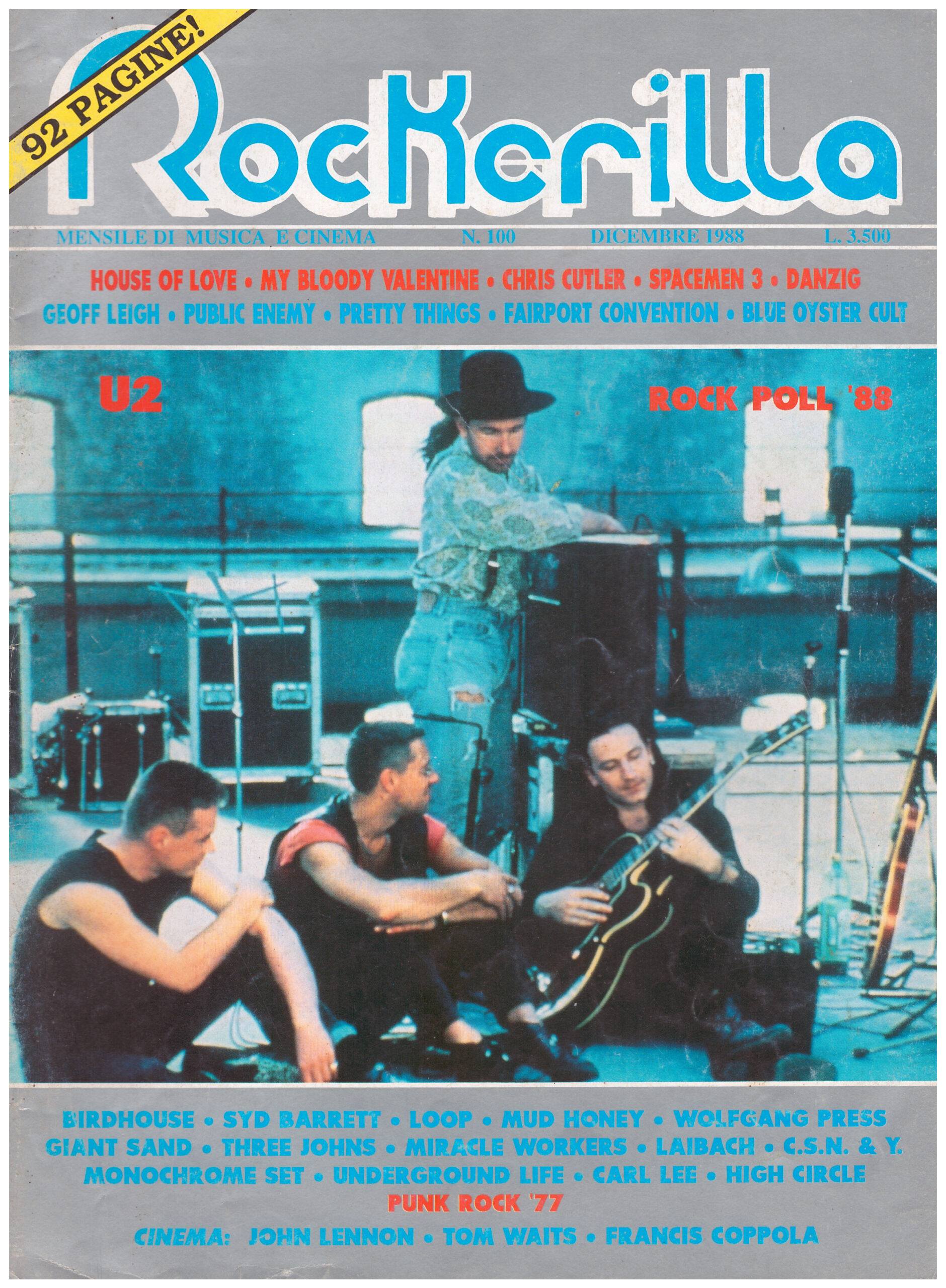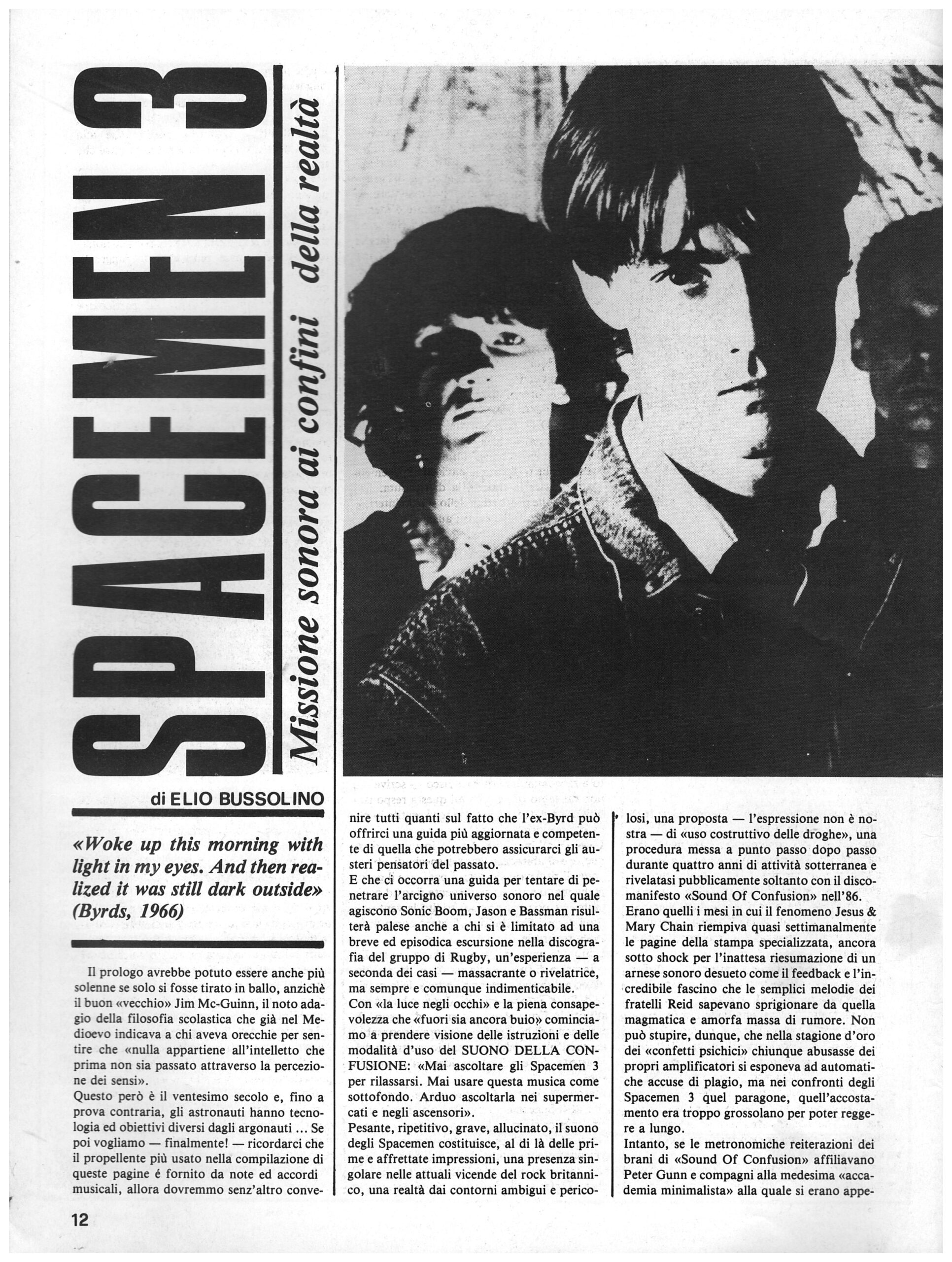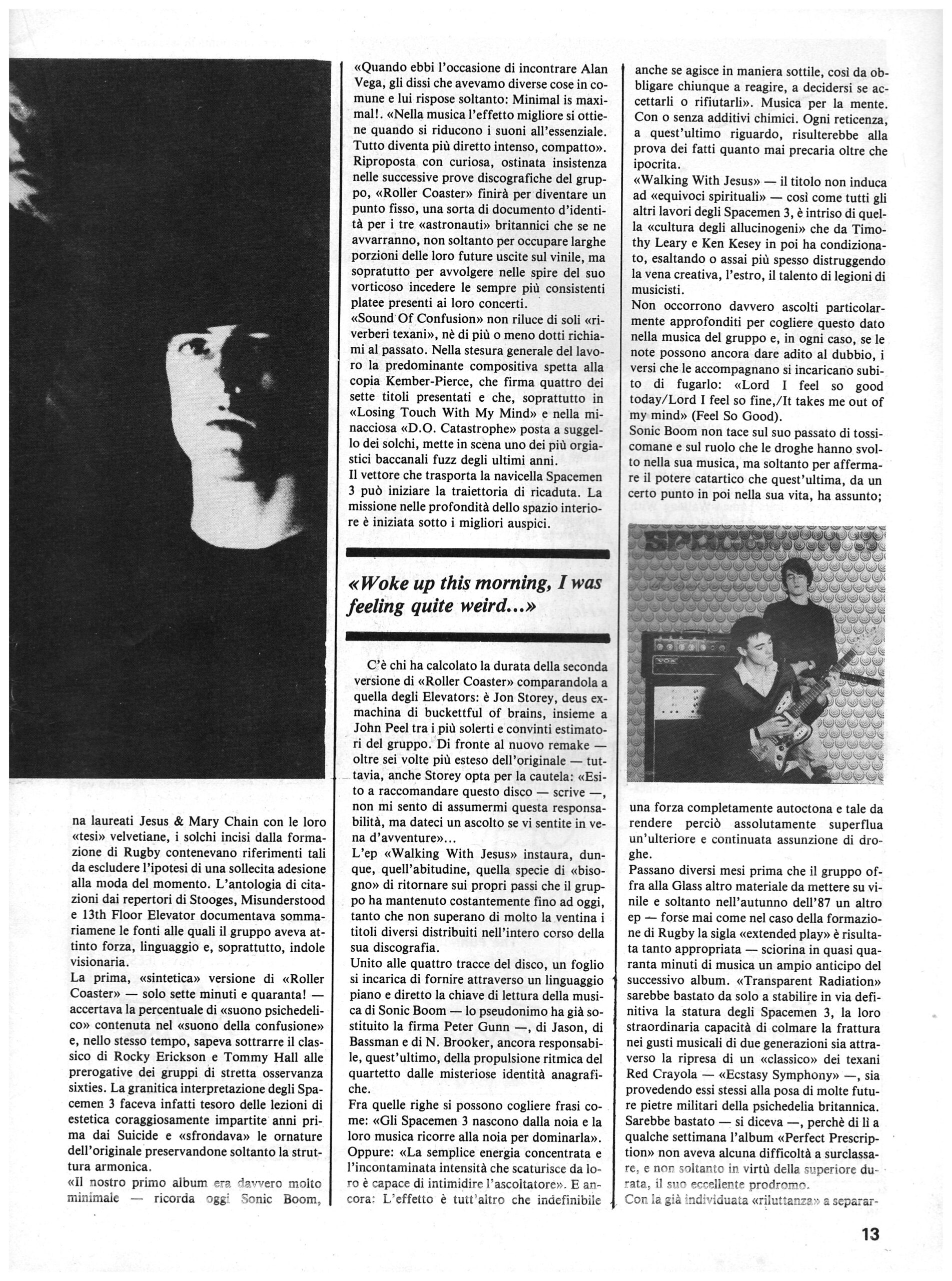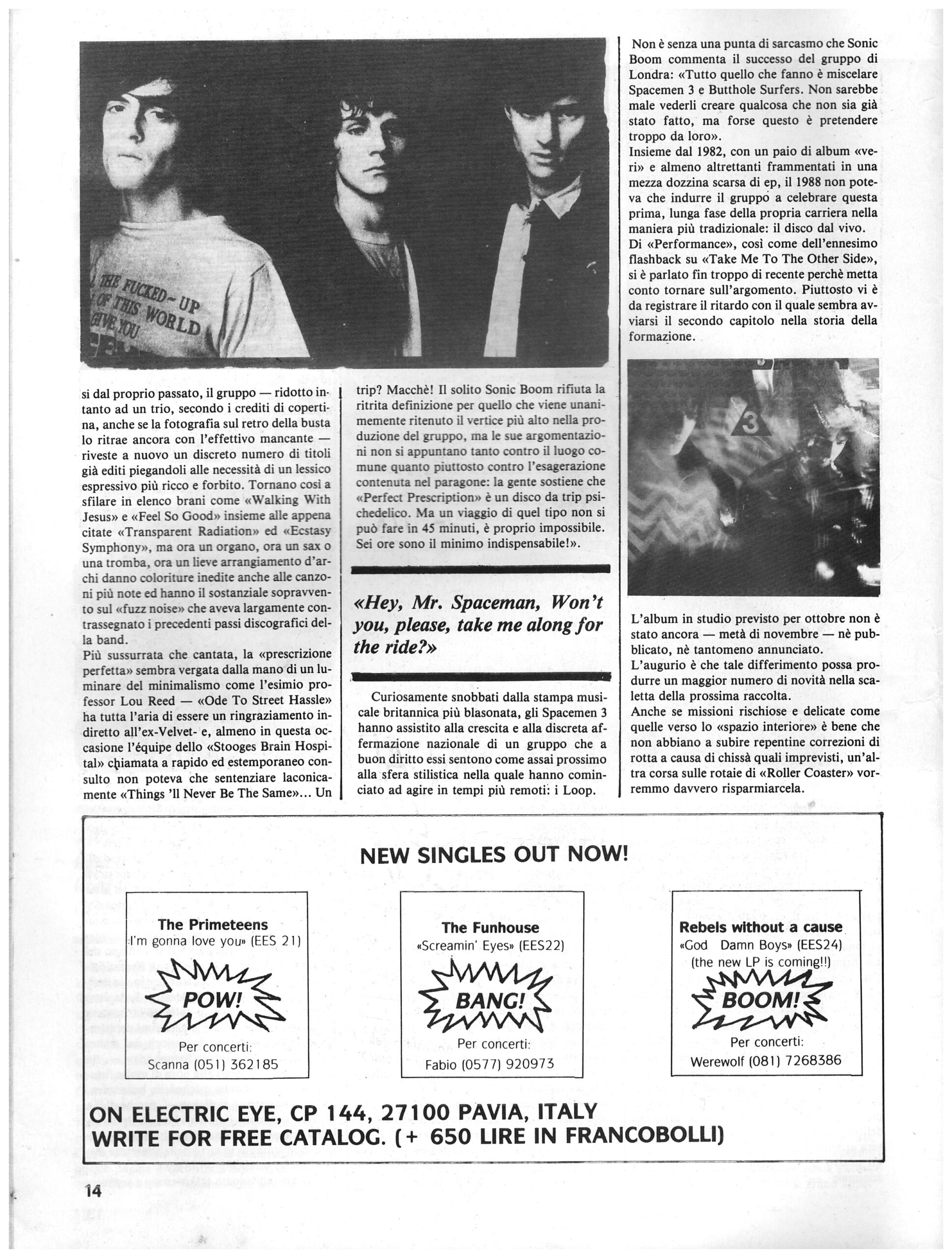Text
Missione sonora ai confini della realtà
di Elio Bussolino
“Woke up this morning with light in my eyes. And then realized it was still dark outside.” (Byrds, 1966)
Il prologo avrebbe potuto essere anche più solenne se solo si fosse tirato in ballo, anzichè il buon “Vecchio” Jim Mc-Guinn, il noto adagio della filosofia scolastica che già nel Medioevo indicava a chi aveva orecchie per sentire che “nulla appartiene all’intelletto che prima non sia passato attraverso la percezione dei sensi”.
Questo però è il ventesimo secolo e, fino a prova contratia, gli astronauti hanno technologia ed obiettivi diversi dagli argonauti… Se poi vogliamo – finalmente! – ricordarci che il propellente più usato nella compilazione di queste pagine é fornito da note ed accordi musicali, allora dovremmo senz’altro convenire tutti quanti sul fatto che l’ex-Byrd può offrirci una guida più aggiornata e competente di quell ache potrebbero assicurarci gli austeri pensatori del passato.
E che ci occorra una guida per tentare di penetrare l’arcigno universe sonoro nel quale agiscono Sonic Boom, Jason e Bassman risulterà palese anche a chi si è limitato ad anu breve ed episodica escursione nella discografia del Gruppo de Rugby, un’esperienza – a seconds dei casi – massacrante o rivelatrice, ma sempre e comunque indimenticabile.
Con “la luce negli occhi” e la piena consapevolezza che “fuori sia ancora buio” cominciamo a prendere vision delle istruzione e delle modalità d’uso del SUONO DELLA CONFUSIONE: “Mai ascoltarla nei supermercati e negli ascensori”.
Pesante, ripetitivo, grave, allucinato, il suono degli Spacemen costituisce, al di là delle prime e affrettate impressioni, una presenza singolare nelle attuali vicende del rock britannico, una reltà dai contorni ambigui e pericolosi, una proposta – l’espressione non è nostra – di “uso costruttivo delle groghe”, una procedura messa a punto passo dopo passo durante quattro anni di attività sotterranea e rivelatasi pubblicamente soltano con il disco-manifesto “Sound Of Confusion” nell’86.
Erano quelli i mesi in cui il fenomeno Jesus & Mary Chain riemiva quasi settimanalmente le pagine della stampa specializzata, ancora sotto shock per l’inattesa riesumazione e l’incredibile fascino che le semplice melodie dei Fratelli Reid sapevano sprigionare da quella magmatica e amorfa massa di rumore. Non può stupire, dunque, che nella stagione d’oro dei “confetti psichici” chiunque abusasse dei propri amplificatory si esponeva ad automatiche accuse di plagio, ma nei confronti degli Spacemen 3 quel paragone, quell’accostamento era troppo grossolano per poter reggere a lungo.
Intanto, se le metronomiche reiterazioni dei brani di “Sound Of Confusion” affiliavano Peter Gunn e compagni alla medesima “accademia minimalista” alla quale si erano appena laureate Jesus & Mary Chain con le loro “tesi” velvetiane, i solchi incise dalla formazione di Rugby contenevano riferimenti tali da escludere l’ipotesi di una sollecita adesione alla moda del momento. L;antologia di citazioni dai repertori di Stooges, Misunderstood e 13th Floor Elevator documentava sommariamene le fonti alle quali il Gruppo aveva attinto forza, linguaggio e, soprattutto, indole visionaria.
La prima, “sintetica” versione di “Roller Coaster” – solo sette minuti e quaranta! – accertava la perdentuale di “suono psichedelico” contenuta nel “suono della confusion” e, nello stesso tempo, sapeva sottrarre il classic di Rocky Erickson e Tommy Hall alle prerogative die gruppi di stretta osservanza sixties. La granitica interpretazione degli Spacemen 3 faceva infatti Tesoro delle lezioni di estetica coraggiosamente impartite anni prima dai Suicide e “sfrondava” le ornature dell’originale preservandone soltanto la struttura armonica.
“Il nostro primo album era davvero molto minimale” – ricorda oggi Sonic Boom, “Quando ebbi l’occasione di incontrare Alan Vega, gli dissi chec avevamo diverse cose in commune e lui rispose soltanto: Minimal is maximal!. Nella musica l’effetto migliore si ottiene quando si riducono i suoni all’essenziale. Tutto diventa più dietto intenso, compatto”. Riproposta con curiosa, ostinato insistenza nelle successive prove discografiche del gruppo, “Roller Coaster” finirà per diventare un punto fisso, una sorta di document d’iidentità per i tre “astronauti” britannici che se ne avvarranno, non soltanto per occpare larghe porzioni delle loro future uscite sul vinile, ma sopratutto per avvolgere nelle spire del suo vorticoso incedere le sempre più consistenti platee presenti ai loro concerti.
“Sound Of Confusion” non riluce di soli “riverberi texani”, nè di più o meno dotti richiami al passato. Nella stesura generale del lavoro la predominante compositiva spetta alla copia Kember-Pierce, che firma quattro dei sette titoli presentati e che, soprattutto in “Losing Touch With My Mind” e nella minacciosa “O.D. Catastrophe” posta a suggello dei solchi, mette in scena uno dei più orgiastici baccanali fuzz degli ultimi anni.
Il vettore che trasporta la navicella Spacemen 3 può iniziare la traiettoria di ricaduta. La missione nelle profondità dello spazio interiore è iniziata sotto i migliori auspici.
“Woke up this morning, I was feeling quite weird…”
C’è chi ha calcolato la durata della seconda versione di “Roller Coaster” comparandola a quella degli Elevators: è Jon Storey, deus ex-machina di bucketful or brains, insieme a John Peel tra i più solerti e convinti estimatori del Gruppo. Di fronte al nuovo remake – oltre sei volte più esteso dell’originale – tuttavia, anche Storey opta per la cautela: “Esito a raccomandare questo disco – scrive – non mi sento di assumermi questa responsabilità, ma dateci un ascolto se vi sentite in vena d’avventure”…
L’ep “Walking With Jesus” instaura, dunque, quell’abitudine, quella specie di “bisogno” di ritornare sui propri passi che il Gruppo ha mantenuto costantemente fino ad oggi, tanto che non superano di molto la ventina i titoli diversi distribuiti nell’intero corso della sua discografia.
Unito alle quattro trace del disco, un foglio si incarica di fornire attraverso un linguaggio piano e diretto la chiave di lettura della musica di Sonic Boom – lo pseudonimo ha già sostituito la firma Peter Gunn –, di Jason, di Bassman e di N. Brooker, ancora responsabile, quest’ultimo, della propulsion ritmica del quartetto dale misteriose identità anagrafiche.
Far quelle righe si possono cogliere frasi come: “Gli Spacemen 3 nascono dalla noia e la loro musica ricorre alla noia per dominarla”. Oppure: “La semplice energia concentrate e l’incontaminata instensità che scaturisce da loro è capace di intimidire l’ascoltatore”. E ancora: “L’effetto è tutt’altro che indefinibile anche se agisce in maniera sottile, così da obbligare chiunque a reagire, a decidersi se accettarli o rifiutarli”. Musica per la mente. Con o senza additive chimici. Ogni reticenza, a quest’ultimo riguardo, risulterebbe alla prova dei fatti quanto mai precariat oltre che ipocrita.
“Walking With Jesus” – il titolo non induca ad “equivoci spirituali” – così come tutti gli altri lavori degli Spacemen 3, è intriso di quella “cultura degli allucinogeni” che da Timothy Leary e Ken Kesey in poi ha condizionato, esaltando o assai puì spesso distruggendo la vena creative, l’estro, Il talent di legion di musicisti.
Non occorrono davvero ascolti particolarmente approfonditi per cogliere questo dato nella musica del Gruppo e, in ogni caso, se le note possono ancora dare adito al dubbio, i versi che le accompagnano si incaricano subito di fugarlo; “Lord I feel so good today/Lord I feel so fine/It takes me out of my mind” (Feel So Good).
Sonic Boom non tace sul suo passato di tossicomane e sul ruolo che le droghe hanno svolto nella sua musica, ma soltanto per affermare il potere catartico che quest’ultima, da un certo punto in poi nella sua vita, ha assunto; una forza completamente autoctona e tale da rendere perciò assolutamente superflua un’ulteriore e continuata assunzione di droghe.
Passano diversi mesi prima che il Gruppo pffra alla Glass altro materiale da mettere su vinile e soltanto nell’autunno dell’87 un altro ep- forse mai come nel caso della formazione di Rugby la sigla “extended play” è risultata tanto appropriate – sciorina in quasi quaranta minuti di musica un ampio anticipo del successive album. “Transparent Radiation” sarebbe bastato da solo a stabilire in via definitive la statura degli Spacemen 3, la loro straordinaria capacità di colmare la frattura nei gusti musicali di due generazioni sia attraverso la ripresa di un “classic” dei texani Red Crayola – “Ecstasty Symphony” – sia provedeno essi stessi alla posa di molte future pietre militari della psychedelia Britannica. Sarebbe bastato – si diceva – perchè di lì a qualche settimana l’album “Perfect Prescription” non aveva alcuna difficoltà a surclassare, e non soltanto in virtù della superior durata, il suo eccellente prodromo.
Con la fià individuate “riluttanza” a separarsi dal proprio passato, il Gruppo – ridotto intanto ad un trio, secondo i crediti di copertina, anche se la fotografia sul retro della busta lo ritrae ancora con l’effettivo mancante – riveste a nuovo un discreto numero di titoli già editi piegandoli alle necessità di un lessico espressivo più ricco e forbito. Tornano così a sfilare in elenco brani come “Walking With Jesus” e “Feel So Good” insieme alle appena citate “Transparent Radiation” ed “Ecstasy Symphony”, ma ora un organo, ora un sax o una tromba, ora un lieve arrangiamento d’archi danno coloriture indedite anche alle canzoni più note ed hanno il sostanziale sopravvento sul “fuzz noise” che aveva largamente contrassegnato i precedent passi disografici della band.
Più sussurrata che cantala, la “prescrizione perfetta” sembra vergata dalla mano di un luminare del minimalismo come l’esimio professor Lou Reed – “Ode To Street Hassle” ha tutta l’aria di essere un ringraziamento indiretto all’ex-Velvet- e, almeno in questa occasione l’équipe dello “Stooges Brain Hospital” chiamata a rapido ed estemporaneo consulto non poteva che sentenziare laconicamente “Things’ll Never Be The Same”… Un trip? Macchè! Il solito Sonic Boom rifiuta la ritrita definizione per quello che viene unanimemente ritenuto il vertice più alto nella produzione del Gruppo, ma le sue argomentazioni non si appuntano tanto contro il luogo commune quanto piuttosto contro l’esagerazione contenuta nel paragone: “la gente sostiene che “Perfect Prescription” è un disco da trip psichedelico. Ma un viaggio di quell tipo non si può fare in 45 mintui, è proprio impossibile. Sei ore sono il minimo indispensabile!”
“Hey, Mr. Spaceman, Won’t you, please, take me along for the ride?”
Curiosamente snobbati dalla stampa musicale Britannica più blasonata, gli Spacemen 3 hanno assistito alla crescita e alla discreta affermazione nazionale di un Gruppo che a buon diritto essi sentono come assai prossimo alla sfera stilistica nella quale hanno cominciato ad agire in tempi più remote: I Loop. Non è senza una punta di sarcasm che Sonic Boom comment ail successo del gruppo di Londra: “Tutto quello che fanno è miscelare Spacemen 3 e Butthole Surfers. Non sarebbe male vederli creare qualcosa che non sia già stato fatto, ma forse questo è pretendere troppo da loro”.
Insieme dal 1982, con un paio di album “veri” e almeno altrettanti frammentati in una mezza dozzina scarsa di ep, il 1988 non poteva che indurre il Gruppo a celebrare questa prima, lunga fase della propria carriera nella maniera più tradizionale: il disco dal vivo.
Di “Performance”, così come dell’ennesimo flashback su “Take Me To The Other Side”, si è parlato fin troppo di recente perchè metta conto tornare sull’argomento. Piuttosto vi è da registrar il ritardo con il quale sembra avviarsi il secondo capitol nella storia della formazione.
L’album in studio previsto per ottobre non è stato ancora – metà di novembre – nè pubblicato, nè tantomeno annunciato.
L’augurio è che tale differimento possa produrre un maggior numero di novità nella scaletta della prossima raccolta.
Anche se missioni rischiose e delicate come quelle verso lo “spazio interiore” è bene che non abbiano a subire repentine correzioni di rotta a causa di chissà quali imprevisti, un’altra corsa sulle rotaie di “Roller Coaster” vorremmo davvero risparmiarcela.
Translation
Sound mission on the edge of reality
by Elio Bussolino
“Woke up this morning with light in my eyes. And then realized it was still dark outside.” (Byrds, 1966)
The prologue could have been even more solemn if only it had been brought up, instead of the good “Old” Jim Mc-Guinn, the well-known adage of scholastic philosophy that already in the Middle Ages indicated to those who had ears to hear that “nothing belongs to intellect that has not previously passed through the perception of the senses”.
But this is the twentieth century and, until proven otherwise, the astronauts have different technologies and objectives from the argonauts … If we want – finally! – remember that the most used propellant in the compilation of these pages is provided by musical notes and chords, then we should certainly all agree that the ex-Byrd can offer us a more up-to-date and competent guide than those which could assure us. austere thinkers of the past.
And that we need a guide to try to penetrate the grim universe of sound in which Sonic Boom, Jason and Bassman act will be obvious even to those who have limited themselves to a short and episodic excursion into the discography of the Rugby Group, an experience – a seconds of cases – exhausting or revealing, but always unforgettable.
With “the light in your eyes” and the full awareness that “it is still dark outside” we begin to take a vision of the instructions and methods of use of the SOUND OF CONFUSION: “Never listen to it in supermarkets and elevators”.
Heavy, repetitive, grave, hallucinated, the sound of Spacemen constitutes, beyond the first and hasty impressions, a singular presence in the current events of British rock, a reality with ambiguous and dangerous contours, a proposal – the expression is not ours – of “constructive use of drugs”, a procedure developed step by step during four years of underground activity and revealed publicly only with the disc-manifesto “Sound Of Confusion” in 86.
Those were the months in which the Jesus & Mary Chain phenomenon reemerged the pages of the specialized press almost weekly, still in shock at the unexpected exhumation and the incredible charm that the simple melodies of the Reid Brothers knew how to emanate from that magmatic and amorphous mass of noise. It is therefore not surprising that in the golden age of “psychic confetti” anyone who abused their amplifiers was exposed to automatic accusations of plagiarism, but with regard to the Spacemen 3 that comparison, that combination was too crude to be able to stand up for long.
Meanwhile, if the metronomic reiterations of the songs of “Sound Of Confusion” affiliated Peter Gunn and his companions to the same “minimalist academy” to which Jesus & Mary Chain had just graduated with their Velvetian “theses”, the grooves engraved by the Rugby team they contained references such as to exclude the hypothesis of a quick adherence to the fashion of the moment. The anthology of quotations from the repertoires of Stooges, Misunderstood and 13th Floor Elevator briefly documented the sources from which the Group had drawn strength, language and, above all, visionary nature.
The first, “synthetic” version of “Roller Coaster” – only seven and forty minutes! – ascertained the percentage of “psychedelic sound” contained in the “sound of confusion” and, at the same time, he knew how to subtract the classic of Rocky Erickson and Tommy Hall from the prerogatives of strictly observing sixties groups. The granite interpretation of the Spacemen 3 in fact treasured the aesthetic lessons courageously imparted years earlier by the Suicides and “pruned” the ornaments of the original, preserving only the harmonic structure.
“Our first album was really very minimal” – Sonic Boom remembers today, “When I had the opportunity to meet Alan Vega, I told him that we had several things in common and he only replied: Minimal is maximal !. In music, the best effect is obtained when the sounds are reduced to the essential. Everything becomes more intense, compact ”. Re-proposed with curious, obstinate insistence in the group’s subsequent record tests, “Roller Coaster” will eventually become a fixed point, a sort of identity document for the three British “astronauts” who will use it, not only to occupy large portions of the their future releases on vinyl, but above all to wrap the increasingly large audiences present at their concerts in the coils of its whirling pace.
“Sound Of Confusion” non riluce di soli “riverberi texani”, nè di più o meno dotti richiami al passato. Nella stesura generale del lavoro la predominante compositiva spetta alla copia Kember-Pierce, che firma quattro dei sette titoli presentati e che, soprattutto in “Losing Touch With My Mind” e nella minacciosa “O.D. Catastrophe” posta a suggello dei solchi, mette in scena uno dei più orgiastici baccanali fuzz degli ultimi anni.
The carrier carrying the Spacemen 3 spacecraft can start the fallback trajectory. The mission in the depths of the inner space began under the best auspices.
“Woke up this morning, I was feeling quite weird…”
There are those who have calculated the duration of the second version of “Roller Coaster” by comparing it to that of the Elevators: it is Jon Storey, deus ex-machina of bucketful or brains, together with John Peel among the most diligent and convinced admirers of the Group. Faced with the new remake – over six times larger than the original – however, Storey also opts for caution: “I hesitate to recommend this record – he writes – I don’t feel like taking on this responsibility, but give us a listen if you feel in the mood. adventure “…
The ep “Walking With Jesus” therefore establishes that habit, that kind of “need” to retrace one’s steps that the Group has consistently maintained up to now, so much so that the twenty different titles distributed in the entire course of his discography.
Combined with the four tracks of the disc, a sheet is responsible for providing the key to the music of Sonic Boom – the pseudonym has already replaced the signature Peter Gunn -, of Jason, Bassman and N. Brooker through a flat and direct language , still responsible, the latter, of the rhythmic propulsion of the quartet from the mysterious personal identities.
Making those lines you can catch phrases like: “Spacemen 3 are born from boredom and their music uses boredom to dominate it”. Or: “The simple concentrated energy and the uncontaminated intensity that springs from them is capable of intimidating the listener”. And again: “The effect is anything but indefinable even if it acts in a subtle way, so as to force anyone to react, to decide whether to accept or reject them”. Music for the mind. With or without chemical additives. Any reticence, in this latter regard, would prove to be the most precarious as well as hypocritical evidence of the facts.
“Walking With Jesus” – the title does not lead to “spiritual misunderstandings” – as well as all the other works of Spacemen 3, it is imbued with that “culture of hallucinogens” that from Timothy Leary and Ken Kesey onwards has conditioned, exalting or much can often destroying the creative streak, the flair, the talent of legion of musicians.
Particularly in-depth listening is not really necessary to grasp this fact in the music of the Group and, in any case, if the notes can still give rise to doubt, the verses that accompany them immediately undertake to dispel it; “Lord I feel so good today / Lord I feel so fine / It takes me out of my mind” (Feel So Good).
Sonic Boom is not silent about his past as an addict and the role that drugs have played in his music, but only to affirm the cathartic power that the latter, from a certain point on in his life, has assumed; a completely indigenous force and such as to make further and continued drug use absolutely superfluous.
Several months pass before the Group offers Glass to another material to put on vinyl and only in the autumn of 1987 another ep- perhaps never as in the case of the Rugby team did the acronym “extended play” prove so appropriate – sciorina in almost forty minutes of music, a large preview of the next album. “Transparent Radiation” alone would have been enough to definitively establish the stature of the Spacemen 3, their extraordinary ability to bridge the gap in the musical tastes of two generations both through the reprise of a “classic” by the Texans Red Crayola – “Ecstasty Symphony ”- both themselves proved the laying of many future military stones of British psychedelia. It would be enough – they said – because in a few weeks the album “Perfect Prescription” had no difficulty in outclassing, and not only by virtue of its superior duration, its excellent prodrome.
With the previously identified “reluctance” to separate from its past, the Group – reduced in the meantime to a trio, according to the cover credits, even if the photograph on the back of the envelope still portrays it with the actual missing – has a discreet number of titles already published, bending them to the needs of a richer and more refined expressive lexicon. Thus, songs such as “Walking With Jesus” and “Feel So Good” along with the aforementioned “Transparent Radiation” and “Ecstasy Symphony” return to parade, but now an organ, now a sax or a trumpet, now a light arrangement of The strings give unprecedented colors even to the most famous songs and have the substantial upper hand on the “fuzz noise” that had largely marked the band’s previous disographic steps.
More whispered than sung, the “perfect prescription” seems to be written by the hand of a luminary of minimalism such as the esteemed Professor Lou Reed – “Ode To Street Hassle” has all the air of being an indirect thanks to the ex-Velvet- and , at least on this occasion the team of the “Stooges Brain Hospital” called for a quick and impromptu consultation could only laconically pronounce “Things’ll Never Be The Same”… A trip? Useless! The usual Sonic Boom rejects the backward definition for what is unanimously considered the highest point in the production of the Group, but his arguments are not so much against the common place as against the exaggeration contained in the comparison: “people argue that “Perfect Prescription” is a psychedelic trip record. But a trip like that can’t be done in 45 minutes, it’s just impossible. Six hours is the bare minimum!”
“Hey, Mr. Spaceman, Won’t you, please, take me along for the ride?”
Curiously snubbed by the most famous British music press, Spacemen 3 have witnessed the growth and the discreet national affirmation of a Group that they rightly feel is very close to the stylistic sphere in which they began to act in more remote times: The Loops. It is not without a hint of sarcasm that Sonic Boom comments on the success of the London group: “All they do is mix Spacemen 3 and Butthole Surfers. It wouldn’t hurt to see them create something that hasn’t already been done, but maybe that’s too much to expect from them ”.
Together since 1982, with a couple of “real” albums and at least as many fragmented in a scarce half-dozen ep, 1988 could only induce the Group to celebrate this first, long phase of their career in the most traditional way: the album from I live.
“Performance”, as well as yet another flashback to “Take Me To The Other Side”, has been talked about too recently for it to be worth returning to the subject. Rather, there is a delay with which the second chapter in the history of formation seems to start.
The studio album scheduled for October has not yet – mid-November – been released, much less announced.
The hope is that this deferral will produce a greater number of innovations in the lineup of the next collection.
Even if risky and delicate missions such as those towards “inner space” it is good that they do not have to undergo sudden course corrections due to who knows what unforeseen events, we would really like to spare ourselves another run on the “Roller Coaster” rails.



